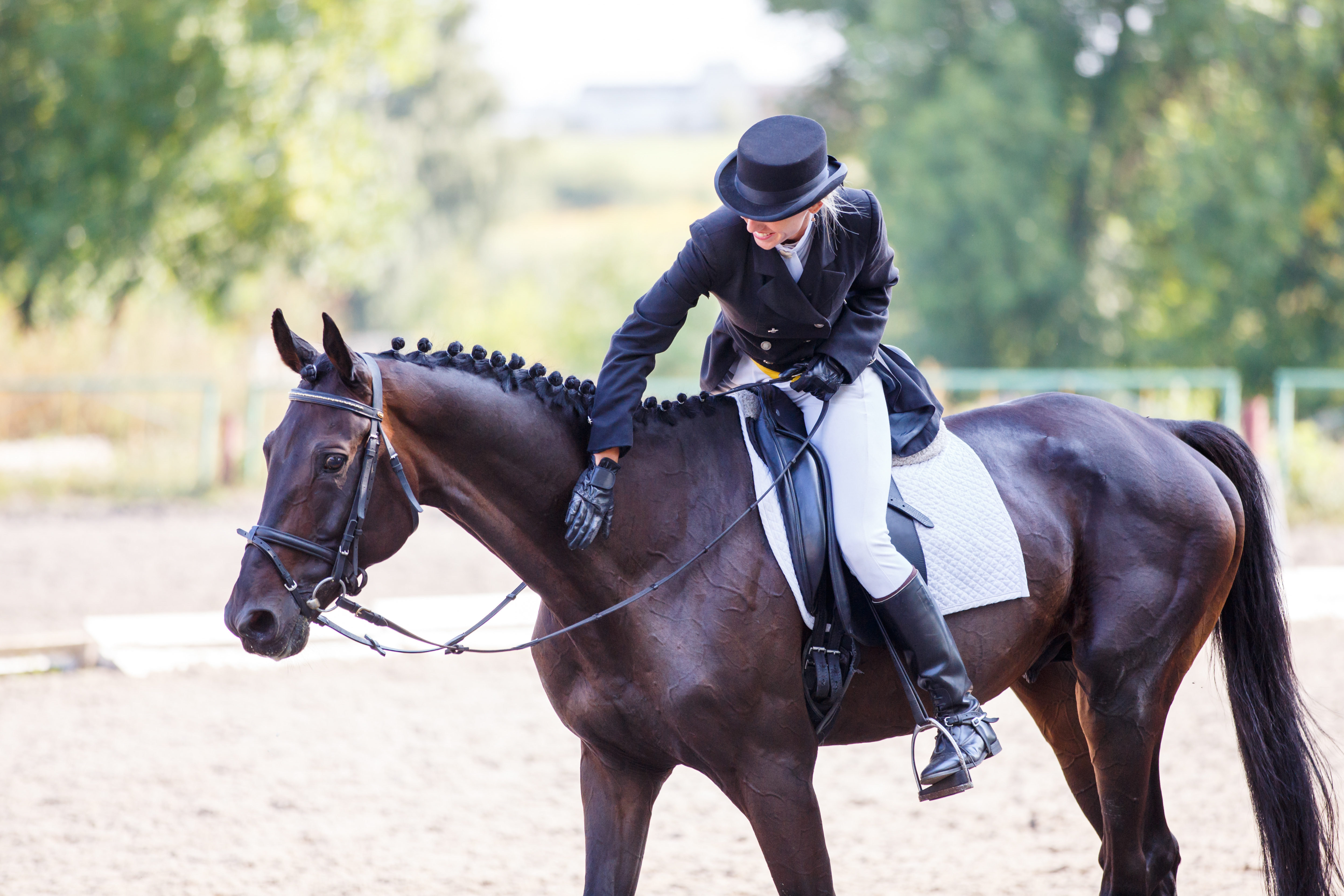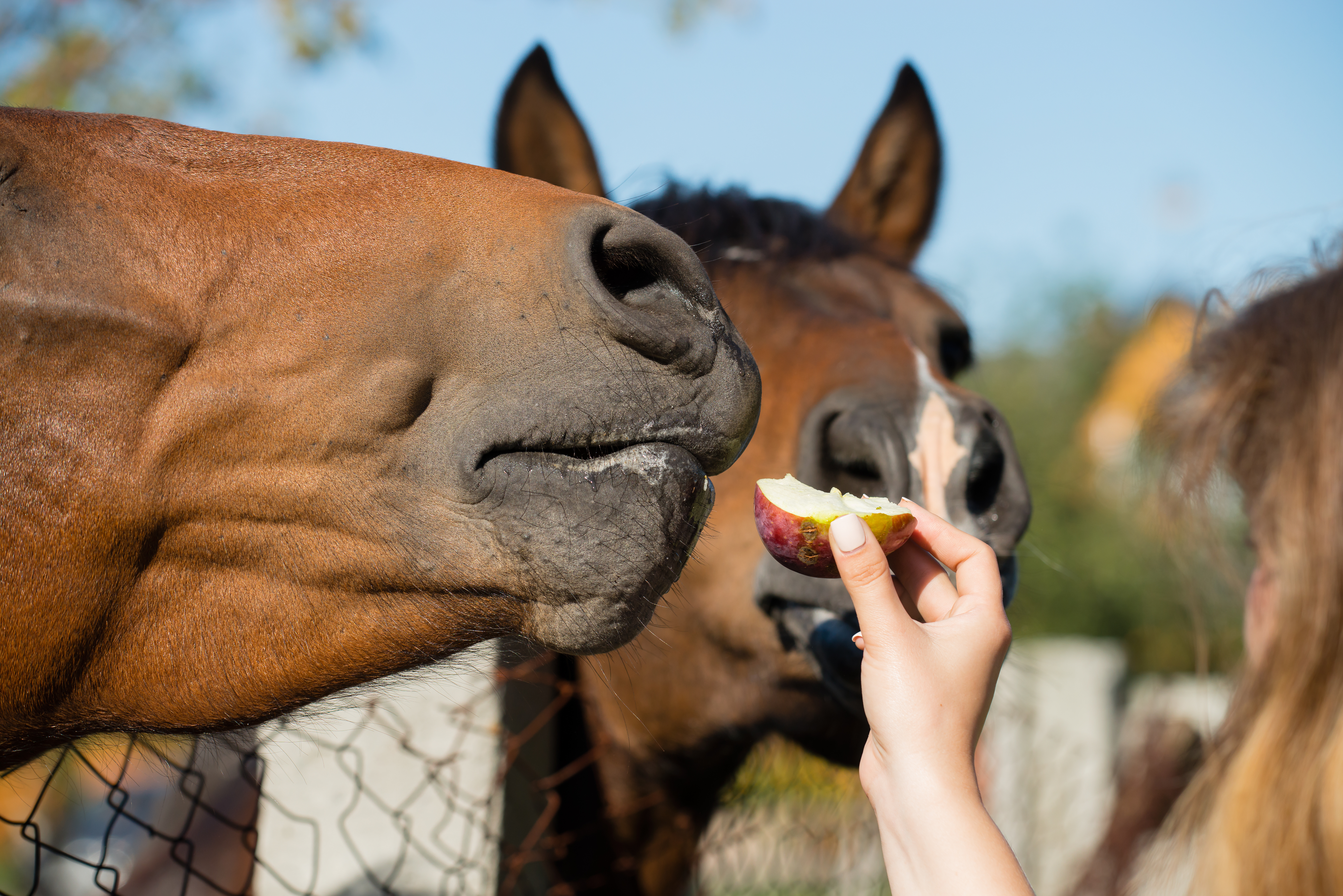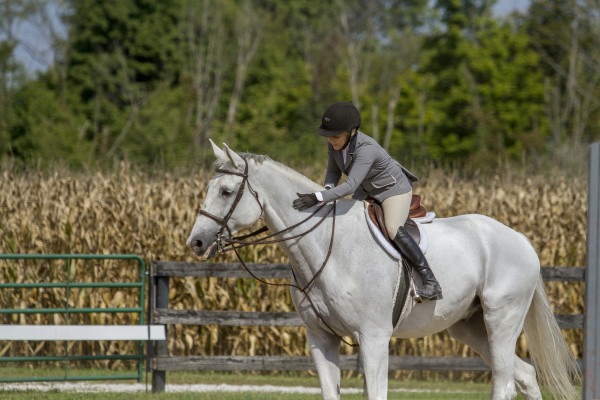The best way to use rewards in horse training
- May 29, 2024
- ⎯ Janet L. Jones, PhD
“May I give your horse a treat?” Friends ask this question out of kindness, and it’s hard to say “no.” But edible rewards are such high-test tools that they can hinder a horse’s training when offered indiscriminately. Success with treats depends on exactly what the horse is doing at a given moment, and on which behaviors you want to encourage or discourage.
The equine brain learns largely by association—linking an action to a consequence. Let’s suppose Monty is bobbing his head up and down over the stall door. Our new friend hands him a chunk of apple because she wants to be nice. Yum! A mental association has formed: Bobbing equals apples. Next thing you know, Monty’s smacking his head up and down harder, more often, and in other contexts, coaxing us to fork over some apple strudel.
Edible treats are like race cars—they work extremely well, but only if you know what you’re doing. One or two instances can be enough to create a new behavior. When it’s a behavior we want, associative clout is wonderful. But we’re less pleased when it’s a behavior we don’t want, like a horse bobbing his head into somebody’s face.
To accommodate a horse’s associative talents, provide the right rewards at the right time, and only for behavior you want to encourage. Usually, the right rewards are non-edible. Unfortunately, we’ll have to tell our treat-wielding friends “no” more often, but our horses and our safety—and theirs—will be better for it. If we understand how horses form associations, we can use behavioral rewards to teach them ground manners, under-saddle performance and the occasional mounted masterpiece. Reward is the most effective form of associative learning because it creates a physical connection that is as real as the spark that moves a piston.
How horses form associations
Most mammals learn by association. Some are much better at it than others, and horses land near the top of the class, thanks to their neurology. Basically, a group or network of neurons represents an action. Think of a simple equine action, like bobbing a head. The brain controls the motion of lifting the head up slightly then allowing its weight to fall as the neck stretches downward. Each time the network fires, the head bobs.

When neurons fire an electrical impulse, their capacity to reactivate remains strong for a few seconds afterward. The associative engine is primed. During the initial activation, or the primed state that follows, any external event can be linked with the initial network. If an apple arrives while the head-bobbing network’s potential to fire is still high, the equine brain will form a connection between the two. Long-term potentiation, as this phenomenon is called, is the Ferrari of horse training—but to train well, you have to learn how to gun the engine without making it backfire.
Cognitive scientists refer to this learning process with an easy verbal reminder coined by Donald Hebb: “Neurons that fire together, wire together.” How? When two networks fire at or very near the same time, chemicals made in the brain are released to strengthen the bond. They shoot across tiny gaps between the two networks and are absorbed by the receiving neurons. They’re like glue that strengthens a new link while it’s under construction.
Dopamine hits
But wait, there’s more! When the second network represents something very pleasant—like a behavioral reward or an edible treat—dopamine wells up in a clump of brain cells called the nucleus accumbens. Dopamine is a “feel-good” substance for human and equine brains. Food when we’re hungry, drinks when we’re dry, laughter when we’re sad, safe completion of a risky maneuver—the happy feeling of these satisfactions comes from dopamine release. Such feelings are so powerful that humans can consciously destroy their health with insatiable appetites for food, alcohol, drugs or extreme sports that kill.
So, let’s review: Neurons represent-ing an action (head-bobbing) fire when a different set of neurons representing a reward (apple) also fire. The brain’s natural chemicals glue the new link together while it’s forming. Practice strengthens the bond. Add reward for a quick shot of dopamine, and you’ve got a level of satisfaction that’s off the charts. Horses remember those lessons and want to learn more.
Rewards: A delicate balance
Humans learn the same way. But human minds trowel many layers of modification over the top of simple associative learning. These layers include cultural standards, social mores, semantic knowledge, personal hopes and expectations, episodic and procedural memories, perceptual filters, ethics and values, cognitive controls, attention, peer pressure, the weather, and all the muscle of varying emotions. OK, maybe not so much the weather, but you get my point: Our minds are stirring a thick brew that often overrides the automatic force of a reward.
Adults are motivated more by a sense of self-regulation than a desire for accolades. We want control of our fates, responsibility for our successes and failures. Even when personal control is limited, we are motivated by believing it exists. Horses don’t care if they are manipulated into a behavior by their desire for a spoonful of sugar. Humans do. Excessive praise backfires with us, especially when proffered for mediocre skills or easy tasks. Over-praised riders, for example, are often discouraged by minor failures and stop trying to improve. An analysis of 128 studies on human motivation shows that too many extrinsic rewards can damage people’s sense of responsibility for achieving their own satisfaction.
Abundant rewards backfire with horses as well. They have less power to shape an animal’s behavior if they are doled out frequently. Treats become run-of-the-mill, more like an aid to nutrition than an opportunity for learning. It’s the surprise of unexpected rewards that produces the greatest release of dopamine in the brain. Preserve your horse’s educational interest by commending when a new action needs reinforcement or a complex maneuver is finally achieved. (The definition of “complex” depends on your horse—something that is difficult for that horse to do, at that time, in that setting.) Up the ante as your horse learns: Two steps of backing are praise-worthy at first, but eventually it should take 20 steps—smoother, straighter, rounder—to earn the same prize.
The many forms of reward
Most people assume that a reward is something very special. But in fact, it’s anything desirable. Horses desire rest, known locations, quiet, equine buddies, familiar people, calm voices, gentle handling, soft hands, clear direction, strokes on the neck, wither scratches, soothing words, consistency, routine, downward transitions … the list goes on. The better the reward, the deeper the associative learning. In other words, we can adjust the value of positive reinforcement by altering the type of reward.

To horses, edible rewards—treats—are crème brulee in Waterford crystal. They become associated with good or bad behavior very quickly. When a horse performs a rare and much-desired act that is complicated, goes against equine nature or has been deeply resisted, he deserves a treat. The rest of the time, train with non-edible rewards. The treat is too powerful to use often.
Treats have another downside: The horse always wants more. He’ll mug for a second tidbit, then gently touch your arm to remind you of your obligation. There’s nothing so bad about a soft touch, but horses can escalate quickly at the prospect of a scrumptious nugget. Over the course of time, they can go from nudging to knocking you down, and from cute baby-nibbles on your sleeve to bone-crushing bites through your arm. Horses don’t know they can hurt you—they just want the candy machine to work.
Non-edible rewards
Make a list of all the non-edible rewards you can offer your horse. Rank the items based on your horse’s desires—every horse is different—and on your ability to deliver the reward at the right time. Most horses find wither scratching and neck stroking much more pleasant than patting. Stroking a horse’s neck reduces his heart rate. It can be done within a second or two of good behavior using the back of your fingers while holding both reins—a distinct advantage when you need to reward at a hand gallop and prefer to avoid a face plant.
Verbal praise is effective during mounted feats because you don’t have to change your body position to provide it. Pair it first with better rewards, so the horse learns that “good job” is a form of praise. After that, the words alone will do the trick. Just avoid the common error of associating verbal praise with slower motion—you don’t want your speed jumper to put on the brakes every time she hears an attagirl.
Timing is everything

The biggest challenge with reward-based training is getting the timing right. Equine research demonstrates that the reward must ensue within 10 seconds of some tasks for an association to be formed. Intervening behaviors cannot occur during that period because mammals associate a reward with whatever happened immediately preceding it. Mistiming is especially detrimental when the reward is a delicious treat. The importance of timing changes with species as well: A dog can be reinforced effectively many seconds after a behavior. Not so with a horse. If you have to fumble around in your pocket for a treat, or were slow to notice a desired behavior, it’s too late. The spark has missed the piston.
Another problem with timing is the failure to discriminate among various actions that the horse is performing at the instant of long-term potentiation. If Monty is standing quietly, minding his manners, then a reward will reinforce that good behavior. But if he’s wiggling, pawing, bobbing, nudging, touching, nibbling, pushing—any manner of misconduct—the same reward will reinforce his bad behavior. Once is enough for quick learners, though most horses require two or three associations for the lesson to stick.
“Power moments”
The most robust instants of a training session (what I call “power moments”) occur just before cooling the horse out, just before you dismount, and just before you return the horse to her stall or pasture. Why? Because rest creates great comfort in the horse.
Use power moments wisely. When you get the perfect slow lope, end your session and cool the horse out. He’ll want to lope like that next time, in hopes of winning the cool-out lottery again. If your horse dislikes backing, have him back one or two steps just before you dismount. Your dismount is the berries. If your horse gets ahead of you on a lead, stop him at his stall door, wait, then put him away. Entering his stall is the Nobel Prize. Whatever simple action your horse avoids, get him to perform a bit of it during a power moment, and you will be teaching a potent lesson.
Accidental rewards
An equally potent lesson occurs when we accidentally reward negative actions during power moments. If you quit a training session in disgust at your horse’s refusal to lope slower than 50 mph, you have just rewarded him for his speed. Dismount while the horse is dancing around and you have rewarded him for unsafe behavior. If the horse hurries you into his stall, you have taught him that pushing is acceptable. Think about how the horse is behaving and whether you are inadvertently rewarding bad conduct.
Pairing the right reward for the task with split-second timing might seem like an impossible standard of perfection. Just try your best, and with practice you will improve. Eventually, associative training becomes second nature. The best trainers manage such unions all day long with little conscious attention.
Click here to learn about clicker training in horses.
Ground manners and mounted performance
With the well-timed use of rewards, horses learn many positive behaviors. Ground manners are taught by reward, so the horse learns to stand in cross-ties, to defecate or urinate in accepted locations, to allow ears and underbellies to be clipped, to receive injections and to lift all four feet. Using associative timing, we teach horses to walk safely on a lead, learning to stop, turn, slow down, speed up, wait or back just by noticing human body language. Ground manners prevent injuries to horses and handlers, and they allow veterinarians and farriers to provide care.
Mounted training is also improved with positive reinforcement. An unstarted horse has a lot to learn. He doesn’t know that the saddle is heavy, or that the bit feels cold, or that you won’t hurt him. Likewise, he doesn’t know how to walk a straight line or turn a corner in the arena when he reaches it. He doesn’t know how to keep his balance while carrying you around that corner. With reward-based training, we ease the unstarted horse’s process of learning, relieving his anxiety and earning his trust.
Lasting results
Associative learning by reward works long after basic training is complete. Hunters and jumpers don’t just automatically trot through ground cavaletti. They’ve been taught through reward not to touch the poles. Later they will be taught by reward to hop crosspoles, and someday with talent they might learn to leap obstacles that stand five feet tall and seven feet wide. In training for any discipline, the horse must come to understand what we want. The best way to convey that is through reward.
Horses learn to generalize associations, too. Suppose you have taught your horse to avoid touching ground poles in the arena. Without generalization, a horse sometimes associates place or time, rather than action, with a given behavior. He could come to believe, for example, that he is not to touch poles when they are painted yellow or located in the covered arena. He’ll need to learn that the lesson holds for all poles in all places. Generalization occurs by practicing new moves in other locations, or with different equipment, using mild rewards. It’s easy to induce.
All horses learn through reward that humans feed and water them. When food is slow to arrive, they put up a fuss. If irresponsible humans forget to fill a water trough, horses will stand near it, whinny, hop, kick, buck, push on the fence, and protest until they get our attention. Zoo-raised horses don’t even know they need to seek food and water when released into the wild. Captive horses have learned, through the associative reward of previous feedings and waterings, that we hold the keys to life.
Gold stars don’t always have to come from us. Many horses learn to escape their stalls to seek edible rewards. Note that this is still reward-motivated behavior: There is something desirable outside the stall that the horse wants—a basket of treats, a path to the pasture, or a cute mare down the aisle. It’s also dangerous behavior: If your horse escapes to the grain bin, the resulting binge puts him at risk of laminitis or worse.
Extinction: An uphill battle
Anyone who has allowed a horse to bite at long grass while out on the trails knows that once taught, a given behavior can be very difficult to change. Extinction refers to the effort to eliminate a pattern of association. Rewarded misbehavior is especially difficult to extinguish, for two reasons. First, misbehavior is often based on instinctual movements developed over millennia of evolution. Pawing, for example, is a natural activity for a bored, hungry or thirsty horse who is confined. Teaching the horse not to follow this instinct will be a challenge.
Second, horses rarely forget a lesson that was once accompanied by an extremely desirable outcome. When horses paw in cross-ties, what often happens next? Yep, their owners become exasperated and put them away. Food, water, rest, comfort and buddies await—a five-factor reward!
The moral of the story? Be careful what you teach your horse by reward, because he might remember it forever.
Reward is the most effective type of associative learning in horses. The brain physiology of long-term potentiation means that we must rate the value of rewards carefully and offer them at the right moment. Handing a horse treats because he’s cute, or allowing a friend to offer him delicious goodies, usually leads to trouble. Instead, save special treats for special performance. In the meantime, train with non-edible rewards. Introduce your new friend to your horse and let her stroke his neck or shoulder. Both parties will appreciate that higher level of care.
About the author
Janet L. Jones, PhD, is a cognitive scientist who applies brain research to the training of horses and riders. Now professor emerita, she taught the neuroscience of perception, language, memory and thought for 23 years and is the author of three books. Jones began riding at age 7 and has schooled hundreds of young horses, competing in hunter, jumper, halter, reining and Western pleasure classes throughout the west. She uses basic principles of dressage in training every horse. Located in Colorado, Jones currently owns a 17.1-hand off-the-track Thoroughbred who makes every day interesting. Reach her at [email protected].
This article first appeared in EQUUS #481
Don’t miss out! With the free weekly EQUUS newsletter, you’ll get the latest horse health information delivered right to your in basket! If you’re not already receiving the EQUUS newsletter, click here to sign up. It’s *free*!








